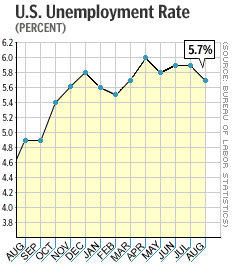NEW YORK (CNN/Money) -
The U.S. unemployment rate fell in August, while job growth gained a little strength, the government reported Friday, as the labor market struggles to recover from more than 1.5 million job cuts last year.
The Labor Department reported that the August unemployment rate fell to 5.7 percent, compared with 5.9 percent in July.

Meanwhile, employers added 39,000 jobs to payrolls in August after adding an upwardly revised 67,000 jobs in July. Economists, on average, expected an unemployment rate of 5.9 percent and 30,000 new jobs, according to Briefing.com.
"There may be some signs that a fledgling recovery is beginning to take hold in the labor market, but we have had these kinds of moves [before], so we don't want to make too much out of it," Jared Bernstein, labor economist at the Economic Policy Institute, told CNNfn's CNNmoney Morning program.
Wall Street cheered the report, sending U.S. stock prices higher in morning trade, while Treasury bond prices fell.
Taking some of the shine off the report was a 68,000-job drop in factory payrolls, the biggest since a 115,000 decline in January, and a 55,000-job drop in retail payrolls.
Offsetting those declines somewhat were 41,000 new jobs added by the government, including several thousand new airport security jobs.
The civilian labor force -- the number of people either working or unemployed and looking for work -- rose by 226,000 in August after falling by 86,000 in July.
The labor force number includes a whopping 429,000 increase in the number of people described as "employed," which seems to contradict the 39,000 increase in non-farm payrolls.
But the labor-force data come from the government's survey of households, which also produces the unemployment figure, while the payrolls data come from a survey of businesses, which is more comprehensive and more stable.
| |
 Related links
Related links
| |
| | |
| | |
|
"The household survey always does this kind of stuff; you get fairly violent moves up and down in total employment figures," said Russ Sheldon, senior economist at BMO Nesbitt Burns. "It's a relatively small survey, so it has inherently larger volatility than the [business survey]."
The bad news about Friday's low unemployment number is that it could encourage even more unemployed people to start looking for work; if there aren't enough new jobs to accommodate them -- between 100,000 and 150,000 every month, according to many economists -- then the unemployment rate could start to rise again.
Despite these troubling aspects of the report, it could ease some of the fears about the future health of consumer spending raised by weak retail-sales data in July and August.
"To the extent that consumer sentiment reacts to movements in the unemployment rate rather than the meager increase in non-farm payrolls, we have to take this ... report as delivering good news to the troops," said Anthony Chan, chief economist at Banc One Investment Advisors.
Consumer spending is critical to the economy, since it fuels about two-thirds of total U.S. gross domestic product (GDP), the broadest measure of economic strength.
The jobs report could also discourage the Federal Reserve from cutting its target for short-term interest rates when its policy makers meet on Sept. 24.
On the brighter side of Friday's report, average hourly earnings rose 4 cents, or 0.3 percent, to $14.82.
The length of the average work week rose to 34.1 from 34 in July, while the average number of overtime hours rose to 4.2 from 4.0.
The increase in hours worked, combined with an increase in the number of temporary workers hired in August, are hopeful signs that businesses could be gearing up to spend and hire more workers.
A slowdown in business spending in late 2000 led to a prolonged slump in manufacturing, a wave of job cuts and a recession in the broader economy.
Many economists have compared the current recovery from that recession to the so-called "jobless" recovery from the 1990-91 recession, in which economic activity improved, but unemployment kept rising. Friday's data, if representing a trend, could mean the labor market is about to turn a corner.
"Corporations may be ultra-cautious, but at least they're not slashing jobs, and that's a net positive," said Bill Cheney, chief economist at John Hancock Financial Services.

|

